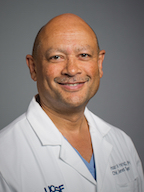Giant Abdominal Wall Hernia
A giant abdominal wall hernia can develop from an existing ventral or incisional hernia, sometimes arising after one or more failed repair attempts. These hernias may also result from a traumatic injury where the abdomen was required to be left open and healing was delayed. In giant abdominal wall hernias, multiple loops of intestines and sometimes other abdominal organs reside within the hernia sac. The abdominal wall muscles then become conditioned to this and retract reducing the available space inside the abdomen.
The Center for Hernia Repair & Abdominal Wall Reconstruction provides state-of-the-care for treatment of giant abdominal wall hernias, such as the progressive pneumoperitoneum procedure, a specialized approach for treating very large ventral hernias. Our patient outcomes far surpass the national average. Patients with complex ventral hernias treated at UCSF have a recurrence rate of approximately 18 percent, compared to a 30 to 40 percent recurrence rate nationally. Our general surgery team has expertise in the full range of therapeutic options. General and plastic surgeons work closely together to perform optimal abdominal wall reconstruction.
Symptoms
- Very unsightly bulging of the abdominal wall
- Chronic, non-healing wounds
- Immobility and back pain.
Diagnosis
- Physical examination
- CT scan
- MRI
Treatment
Abdominal surgery is required to repair a giant abdominal wall using a combination of complex mesh repair and/or utilizing a "components separation" procedure.
Components Separation
This procedure is performed for giant abdominal wall hernias where there is insufficient muscular wall that can be pulled back together. This surgery separates and advances the layers of the abdominal wall muscle, lengthening them so they reach of each side towards the mid-line.
For More Information
Ventral Hernia Repair (American College of Surgeons)
Massive Ventral Hernias - Presentation by Dr. Hobart Harris








